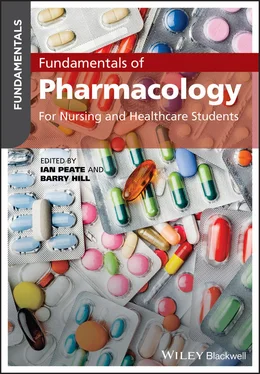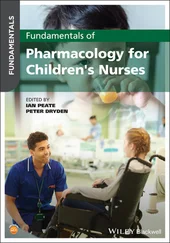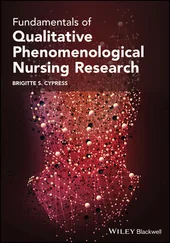24 Chapter 16: Medications and the nervous system Aim Introduction Epilepsy Parkinson's disease Strokes Multiple sclerosis Disease‐modifying drugs Conclusion References Further reading Multiple choice questions
25 Chapter 17: Medications used in mental health Aim Antidepressants Antipsychotics Mood stabilisers Anticonvulsants Anxiolytics and hypnotics Drugs for dementia References Further reading Multiple choice questions
26 Chapter 18: Immunisations Introduction Ethics Immunity How vaccines work The Green Book Storage Contraindications Patient group direction/patient specific direction Conclusion References Further reading
27 Normal Values
28 Answers
29 Index
30 End User License Agreement
1 Chapter 1 Table 1.1 Registered nurse procedural competencies and the procedural compete...
2 Chapter 2 Table 2.1 Font colour and information purpose Table 2.2 Abbreviations of medication categories Table 2.3 Examples of local and national prescribing guidelines
3 Chapter 4 Table 4.1 The potential risks of missed medicationTable 4.2 Four principles of medicines management
4 Chapter 5Table 5.1 Factors that affect absorption of drugsTable 5.2 Examples of opioid by receptor binding
5 Chapter 8Table 8.1 Examples of non‐opioids and non‐steroidal anti‐inflammatory drugs (...Table 8.2 Examples of opioids and the associated pharmacokinetics, pharmacody...
6 Chapter 9Table 9.1 Classifications of antimicrobials with examplesTable 9.2 Broad‐ and narrow‐spectrum antibiotics with examplesTable 9.3 Spectrum classifications with examples and indications.Table 9.4 Pharmacokinetics of benzylpenicillin sodium.Table 9.5 Examples of cephalosporin per generation.Table 9.6 Pharmacokinetics of cephalosporins.Table 9.7 Pharmacokinetics of imipenem.Table 9.8 Pharmacokinetics of tetracyclineTable 9.9 Pharmacokinetics of chloramphenicol.Table 9.10 Pharmacokinetics of aminoglycosidesTable 9.11 Pharmacokinetics of erythromycin.Table 9.12 Pharmacokinetics of clindamycin
7 Chapter 10Table 10.1 Healthy cholesterol profile (Department of Health (DH), National H...Table 10.2 Criteria for metabolic syndrome. Metabolic syndrome is present if ...Table 10.3 Criteria for diagnosis of hypertension (NICE CG 136, 2019).Table 10.4 Comparing common adverse effects of diuretics.Table 10.5 Digoxin overdose and toxicity.Table 10.6 Differences in DOACs indications and clinical considerations.
8 Chapter 11Table 11.1 Segments of the nephron and their functions.Table 11.2 Pre‐renal, intrinsic and post‐renal causes of AKI.Table 11.3 AKI severity classifications.Table 11.4 Definitions and causes of urinary incontinence.Table 11.5 Common renal drugs.Table 11.6 Loop diuretics and their related pharmacology.Table 11.7 Thiazide diuretics and their related pharmacology.Table 11.8 Osmotic diuretics and their related pharmacology.Table 11.9 Potassium‐sparing diuretics and their related pharmacology.Table 11.10 Carbonic‐anhydrase inhibitors and their related pharmacology.Table 11.11 Phosphate binders and their related pharmacology.Table 11.12 Vitamin D supplements and their related pharmacology.Table 11.13 Potassium binders and their related pharmacology.Table 11.14 Potassium supplements and their related pharmacology.Table 11.15 Bicarbonate supplementation and the related pharmacology.Table 11.16 α 1receptor antagonists for urinary tract disorders and their rel...Table 11.17 Receptors of the autonomic nervous system.Table 11.18 Androgen‐synthesis (5α‐reductase) and Phosphodiesterase type 5 (P...Table 11.19 Antimuscarinic drugs and their related pharmacology.
9 Chapter 12Table 12.1 Skills and desired outcomes of a stagedTable 12.2 Choice of second agents in treatment people with type 2 diabetes p...Table 12.3 Insulin regimens and names of insulins in use in the UK
10 Chapter 13Table 13.1 Types of cells which reside within the respiratory tract.Table 13.2 The causes of bronchiectasis by category.Table 13.3 Common respiratory drugs.Table 13.4 Severity of illness and clinical conditions requiring oxygen thera...Table 13.5 Comparison of advantages and disadvantages of pulse oximetry.Table 13.6 Physiological and clinical risks of hyperoxemia.Table 13.7 Oxygen therapy devices.Table 13.8 Short‐acting β 2adrenoceptor agonists and their related pharmacolo...Table 13.9 Long‐acting β 2adrenoceptor agents and their related pharmacology....Table 13.10 Muscarinic antagonist agents and their related pharmacology.Table 13.11 Xanthine agents and their related pharmacology.Table 13.12 Corticosteroid agents and their related pharmacology.Table 13.13 Immune modulator agents and their related pharmacology.Table 13.14 Mucolytic agents and their related pharmacology.
11 Chapter 15Table 15.1 Commonly used alkylating drugs.Table 15.2 Commonly used antimetabolites.Table 15.3 Commonly used anthracyclines and other antibiotics.Table 15.4 Commonly used vinca alkaloids.Table 15.5 Properties of cyclophosphamide.Table 15.6 Examples of monoclonal antibodies.Table 15.7 Demonstrates properties of Rituximab as a monoclonal antibody.Table 15.8 Other checkpoint inhibitors.Table 15.9 Indications for use of transplant.Table 15.10 Examples of adoptive cell transfer drugs.Table 15.11 Examples of cytokines.Table 15.12 Side effects of immunotherapy.Table 15.13 Examples of corticosteroid use in cancer.Table 15.14 Examples of corticosteroid.Table 15.15 Dexamethasone.Table 15.16 Side effects of Corticosteroids.
12 Chapter 16Table 16.1 Classification of seizuresTable 16.2 AED by seizure type
13 c17Table 17.1 Required washout periods when switching to an MAOITable 17.2 Symptoms associated with hyponatremiaTable 17.3 Risk factors for developing antidepressant related hyponatremiaTable 17.4 Symptoms of serotonin syndromeTable 17.5 Antidepressant discontinuation symptomsTable 17.6 Antipsychotic related side effectsTable 17.7 Antipsychotic pre‐treatment monitoringTable 17.8 Principles of sleep hygiene.
14 Chapter 18Table 18.1 Vaccine‐preventable diseases.Table 18.2 National immunisation programs.Table 18.3 Pharmacodynamics and pharmacokinetics of vaccines.
1 Chapter 1 Figure 1.1 A systematic approach to care provision. Figure 1.2 The Code. Source: Olympus America, Inc. With permission.
2 Chapter 2 Figure 2.1 Extract drug class monograph. Figure 2.2 Contraindication and class monograph. Figure 2.3 Home page of MIMS online. Figure 2.4 How to determine if a drug or devise can be prescribed on the NHS...
3 Chapter 3 Figure 3.1 Acts or laws affecting the provision of medicines.
4 Chapter 5Figure 5.1 An integration of ADME and the routes of administration.Figure 5.2 Medication delivery to baby during gestation.Figure 5.3 Hepatic first‐pass metabolism (first‐pass effect).Figure 5.4 Pharmacokinetics (ADME) and the main anatomical structures/physio...Figure 5.5 Injectable routes of administration.Figure 5.6 Diagram illustrating how a transdermal patch works.Figure 5.7 (a) The step‐by‐step process of a second messenger system. (b) St...
5 Chapter 6Figure 6.1 Sublingual and buccal routes.
6 Chapter 7Figure 7.1 Anaphylaxis eyes.Figure 7.2 Anaphylaxis lips.Figure 7.3 Anaphylaxis tongue.Figure 7.4 Rash.Figure 7.5 Serum sickness.Figure 7.6 ‘Yellow Card’ notification for suspected adverse drug reactions....
7 Chapter 8Figure 8.1 Pain pathway.Figure 8.2 Types of pain.Figure 8.3 Example of assessment domains.Figure 8.4 Example of mnemonics used for assessment of pain.Figure 8.5 Example of non‐pharmacological management strategies.Figure 8.6 Classifications of pharmacological analgesics (examples).Figure 8.7 Analgesic ladder.Figure 8.8 Additional equipment that may be required.
8 Chapter 9Figure 9.1 Bacteria.Figure 9.2 Sites of action of different types of antibiotic agent. DNA, PABA...
Читать дальше












